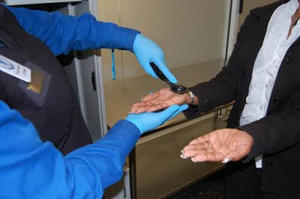Explosives detectionTSA could begin searching for explosives hidden inside you
Government intelligence officials are now warning airlines that terrorists could be using surgically implanted explosives to bypass security measures; there is no information regarding a specific plot or threat, but airlines could begin to implement additional screening procedures as the current body scanners cannot effectively detect bombs hidden inside an individual; last year, al Qaeda operatives in Iraq implanted two dogs with explosives, but the dogs died before they could loaded onto a U.S.-bound plane

Swabbing hands for explosive residue // Source: consumertraveler.com
Government intelligence officials are now warning airlines that terrorists could be using surgically implanted explosives to bypass security measures.
There is no information regarding a specific plot or threat, but airlines could begin to implement additional screening procedures as the current body scanners cannot effectively detect bombs hidden inside an individual.
According to the Los Angeles Times, U.S. officials have received new information that suggest terrorists may be seriously considering surgically implanting explosive devices to circumvent existing screening procedures.
In response, Nicholas Kimball, a spokesman for the Transportation Security Administration (TSA), said airline passengers flying into the United States will likely face additional screening measures.
“These measures are designed to be unpredictable, so passengers should not expect to see the same activity at every international airport,” Kimball said. “Measures may include interaction with passengers, in addition to the use of other screening methods such as pat-downs and the use of enhanced tools and technologies.”
Current body scanners cannot detect explosive materials hidden in body cavities or below the skin, so airport screeners will rely on explosive trace detection swabs.
In 2009, in a failed suicide bomb attack aimed at assassinating Prince Mohammed Bin Nayef, the head of Saudi Arabia’s counterterrorism operations, an al Qaeda operative hid a pound of high explosives and a detonator in his rectum.
Using this technique, the suicide bomber was able to avoid two sets of airport security screening systems, palace security, and more than thirty hours of close observation by the prince’s secret service agents. The bomber attended a meeting with the prince where he detonated the bomb killing himself and lightly injuring the prince.
